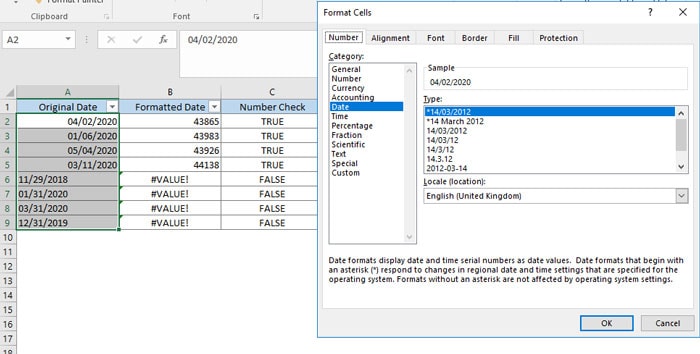Excel Links Not Working Can Be Fun For Everyone
Wiki Article
The 9-Minute Rule for Excel Links Not Working
Table of ContentsExcel Links Not Working Can Be Fun For EveryoneExcel Links Not Working Things To Know Before You BuyExcel Links Not Working for BeginnersThe Single Strategy To Use For Excel Links Not WorkingThe 8-Minute Rule for Excel Links Not Working

Nonetheless, array computation features like either can not manage entire column referrals or determine all the cells in the column. User-defined functions don't instantly identify the last-used row in the column and also, as a result, frequently compute whole column references inefficiently. It is simple to program user-defined functions so that they recognize the last-used row.

The Definitive Guide to Excel Links Not Working
Making use of the formula for a dynamic range is normally preferable to the formula since has the downside of being an unstable function that will be computed at every recalculation. Performance lowers because the feature inside the vibrant array formula have to examine lots of rows.$A$ 1) - 1,1) You can likewise use functions such as to create vibrant ranges, however is unstable as well as always determines single-threaded.
Making use of multiple dynamic arrays within a single column needs special-purpose counting features. Using numerous vibrant arrays can reduce efficiency. In Workplace 365 version 1809 and later, Excel's VLOOKUP, HLOOKUP, and MATCH for exact suit on unsorted data is much faster than ever prior to when looking up numerous columns (or rows with HLOOKUP) from the exact same table array.
If you use the exact suit choice, the computation time for the feature is proportional to the number of cells checked prior to a match is found. Lookup time making use of the approximate suit options of,, as well as on arranged data is quick and is not considerably enhanced by the size of the range you are looking up.
Rumored Buzz on Excel Links Not Working
Ensure that you comprehend the match-type and also range-lookup options in,, and. The following code instance reveals the syntax for the function. For additional information, see the Suit method of the Worksheet, Function have a peek at these guys item. SUIT(lookup worth, lookup variety, matchtype) returns the largest suit much less than or equal to the lookup value when the lookup array is sorted rising (approximate match) (excel links not working).The default alternative is approximate suit arranged rising. demands a specific match and assumes that the data is not arranged. returns the tiniest match greater than or equivalent to the lookup worth if the lookup array is sorted coming down (approximate suit). The following code example reveals the syntax for the and features.
VLOOKUP(lookup worth, table array, col index num, range-lookup) HLOOKUP(lookup value, table selection, row index num, range-lookup) returns the biggest match less than or equivalent to the lookup value (approximate match). This is the default choice. Table variety must be arranged ascending. demands a precise match and thinks the data is not arranged.
All about Excel Links Not Working
If your information is arranged, yet you desire a precise suit, see Use two lookups for sorted information with missing out on worths. Try using the and also works as opposed to. Is a little faster (around 5 percent faster), less complex, as well as utilizes less memory than a mix of as well as, or, the extra flexibility that and also offer often enables you to considerably conserve time.
The function is quick and also is a non-volatile feature, which speeds up recalculation. The function is likewise quickly; nevertheless, it is an unpredictable function, as well as it often considerably raises the time taken to refine the computation chain. It's easy to transform to as well as. The complying with two declarations return the exact same answer: VLOOKUP(A1, Data!$A$ 2:$F$ 1000,3, False) INDEX(Data!$A$ 2:$F$ 1000, MATCH(A1,$A$ 1:$A$ 1000,0),3) Because specific match lookups can be slow, think about the adhering to choices for improving efficiency: Make use of one worksheet.
When you can, the data first (is rapid), and also make use of approximate match. When you must view website utilize a precise match lookup, restrict the series of cells to be checked to a minimum. Use tables and also organized referrals or dynamic variety names as opposed to describing a a great deal of rows or columns.
Excel Links Not Working for Beginners
Two approximate matches are considerably faster than one precise match for a lookup over greater than a couple of rows. (The breakeven point has to do with 10-20 rows.) If you can sort your information yet still can not use approximate suit since you can not make click resources sure that the value you are seeking out exists in the lookup array, you can use this formula: IF(VLOOKUP(lookup_val, lookup_array,1, Real)=lookup_val, _ VLOOKUP(lookup_val, lookup_array, column, True), "notexist") The initial part of the formula works by doing an approximate lookup on the lookup column itself.VLOOKUP(lookup_val, lookup_array, column, Real) If the response from the lookup column did not match the lookup worth, you have a missing value, and also the formula returns "notexist". Know that if you search for a worth smaller than the smallest value in the checklist, you obtain an error. You can manage this mistake by using, or by adding a little examination value to the checklist.
Beginning with Excel 2007, you can use the function, which is both basic and fast. IF IFERROR(VLOOKUP(lookupval, table, 2 FALSE),0) In earlier variations, a straightforward yet slow method is to use a function which contains 2 lookups. IF(ISNA(VLOOKUP(lookupval, table,2, FALSE)),0, _ VLOOKUP(lookupval, table,2, FALSE)) You can prevent the double precise lookup if you use specific once, store the outcome in a cell, and after that evaluate the outcome before doing an.
Report this wiki page